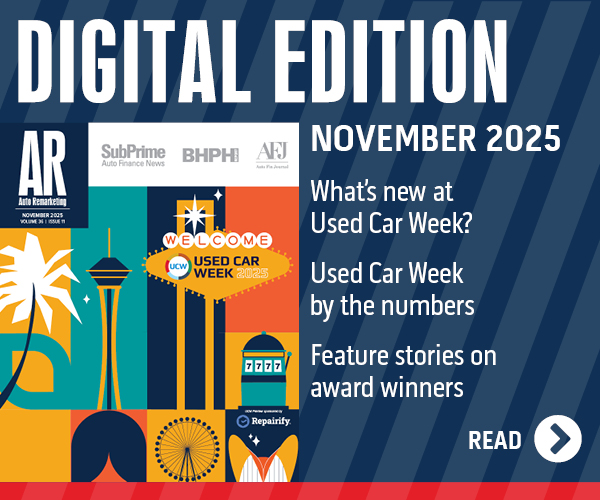GrooveCar recently highlighted credit unions from 14 different states joined its online vehicle buying program during the fourth quarter.
GrooveCar, which provides credit union partners with continuous support services, market consulting, marketing collateral support to optimize communications with members and more, indicated that 17 credit unions joined during Q4, raising the 2017 total to 84.
The company added that it has forged more than 250 credit union partnerships since 2015.
“This has been an exceptional year for helping credit unions reach new levels in auto loan growth,” said Robert O’Hara, vice president of strategic alliances at GrooveCar.
“It’s always gratifying to deliver a service that meets the members’ desire to shop for all their vehicle needs online,” O’Hara continued.
“Credit unions are steeped in member resources, an auto resource is another way to serve the member with what they are looking for,” he went on say.
The GrooveCar platform helps credit unions capitalize on the desire of members to research and purchase a vehicle. The program works to engage members at all stages, especially as the process begins.
GrooveCar can help credit unions close the sales and shopping loop between the member, the credit union and the dealership. When the credit union is in the initial sales space with the member, GrooveCar believes there is a distinct advantage for the credit union to maintain their relevance from the beginning.
Joining the program during Q4 were:
Texas
Abilene Teachers Federal Credit Union, serving 46,470 members with assets of $428 million
WesTex Community Credit Union, serving 11,003 members with assets of $80 million
California
Antioch Community Federal Credit Union, serving 1,572 members with assets of $27 million
Missouri
Arsenal Credit Union, serving 25,548 members with assets of $227.2 million
Oklahoma
Central Oklahoma Federal Credit Union, serving 2,839 members with assets of $29 million
Nebraska
Family Focus, serving 2,820 members with assets of $32 million
Georgia
Georgia Power Valdosta Federal Credit Union, serving 3,579 members with assets of $24 million
Habersham Federal Credit Union, serving 3,724 members with assets of $20 million
Memorial Health Credit Union, serving 4,151 members with assets of $19 million
Mississippi
Hope Credit Union, serving 34,079 members with assets of $201 million
Michigan
Lake Trust Credit Union, serving 180,000 members with assets of $1.8 billion
Massachusetts
Merrimack Valley Federal Credit Union, serving 47,883 members with assets of $598 million
Wisconsin
N.E.W. Credit Union, serving 10,120 members with assets of $87 million
Connecticut
Tobacco Valley Teachers Federal Credit Union, serving 3,873 members with assets of $47 million
Florida
University Credit Union, serving 17,212 members with assets of $206 million
Oregon
Wauna Federal Credit Union, serving 24,222 members with assets of $232 million
Minnesota
West Metro Schools Credit Union, serving 2,500 members with assets of $28 million
With the number of vehicles on the road continuing to climb, vehicle ownership and financing remains a priority for a member at all stages of life. It’s important for credit unions to provide a resource that can serve members’ needs with the latest digital shopping tools.
“Our responsive technology delivers all the features the member enjoys when starting the process, just curious or full-on ready to buy,” O’Hara said. “We help keep the credit union connected at all stages with lead generation tools built into such features as; vehicle searches and saves, loan calculation, trade-in values, free CARFAX reports and other valuable interactive features."
More details are available at www.groovecar.com.
DriveTime might be still searching for a new chief executive officer, but the retailer that specializes in working with consumers with soft credit now has more resources for originations.
Ally Financial on Wednesday announced that it has entered into an agreement to purchase retail contracts from DriveTime.
Under the agreement, Ally will make up to $750 million available to DriveTime for the purchase of retail contracts over the coming year.
“We’re excited to work with DriveTime to provide committed financing that frees up capital it can use to grow its business,’’ said Tim Russi, president of auto finance at Ally.
“Our expertise allows us to support DriveTime in a way that complements our well-established indirect model,” Russi continued.
Under the terms of the agreement, Ally will provide committed financing for the purchase of retail contracts for 12 months. The agreement supports DriveTime’s expansion into the near prime segment.
“This relationship with Ally enables us to grow originations, diversify our retail and finance platforms and enter into a new consumer segment, while still maintaining the exceptional customer experience we take pride in delivering,’’ said Kurt Wood, chief financial officer of DriveTime.
“We appreciate Ally’s financing agility in implementing an innovative solution to meet our needs,” Wood added.
The relationship with Ally arrived about three weeks after DriveTime indicated that the company is currently searching for a CEO for its retail operations.
Boosting its workforce worked out nicely for CRIF Select.
CRIF Select, a division of CRIF Lending Solutions and provider of indirect auto finance partner programs, announced on Wednesday that the company surpassed $3.7 billion in funded paper volume for 2017.
Executives highlighted the milestone is the culmination of a year where CRIF Select renewed its commitment to being a dealership-friendly partner, connecting them to finance companies of all sizes across the country.
To strengthen ties with dealerships, CRIF Select increased its team of dealer-focused representatives to 18 fulltime staff members. It also reinvested in its operations by opening a new state-of-the-art office in Denver for its processing and support staff.
CRIF Select specializes in indirect auto finance partner programs. With an expert focus on dealer and market management, CRIF Select supports a client base of more than 3,500 auto dealers and 90 full-service auto lenders.
Client relationship managers and dealer representatives work together with both the finance company and dealer to create efficient and profitable partnerships that drive business for both sides.
Additionally, CRIF Select’s integrated, technology-based solutions make loan approvals faster, more accurate and virtually paperless, can deliver lower costs for institutions and better service for their customers and members.
By connecting finance companies and dealers through portals such as Dealertrack and RouteOne, CRIF Select can eliminate the traditional stress and hassle associated with dealerships finding the best financing offers in their local markets.
“Last year was a very important year for our team as we positioned ourselves to better serve our lender and dealer partners,” CRIF Select president Jeremy Engbrecht said. “Our expansion to new markets such as Georgia and Wisconsin as well as our renewed commitment to innovation has certainly helped us lead the way.”
Automotive Personnel chief executive officer Don Jasensky offered three options when dealership and auto finance company management teams are faced with the decision of making manpower changes based on performance.
Jasensky leveraged his nearly 30 years of experience, acknowledging that, “Every leader has to make decisions regarding underachieving employees.”
He continued in a company blog post, saying, “When a leader determines that an employee is incapable or unwilling to perform at the required level, it is time to make a change. Once a decision is made to replace an employee the question becomes whom do we replace the employee with?”
When considering that question, Jasensky emphasized three options:
—Do not replace the employee and spread the work among existing staff.
—Promote a person to the position, and replace the junior position.
—Look outside the company for an experienced high achiever.
If the company decides that finding a replacement outside the current workforce is the best option, Jasensky articulated four points to keep the issue with the underperforming employee from snowballing into a larger problem that could derail the positive start to 2018 the store or institution might be enjoying.
Among those points, he noted:
—It is best to find the replacement prior to terminating the employee. You do not want a position to go unfilled for very long.
—It is important that you talk to the best people available. Jasensky recommended that companies not limit themselves to respondents to an advertisement.
“The best people are seldom looking,” he said. “At any given time, only 5 percent to 10 percent of employees are actively looking for a new position. You will be competing both in and outside your industry for their attention.
—If you are not interviewing the best candidates in the marketplace, Jasensky believes the company will not be hiring the best candidate.
—Jasensky also emphasized that managers should keep the position situation confidential.
“Turmoil is created when an employee knows that he or is being replaced,” said Jasensky, who also is a board member of the National Automotive Finance Association.
More workforce recommendations and current industry job listings can be found by going to Automotive Personnel’s website.
The evidence continues to mount showing how much auto finance companies are tightening their underwriting and slowing the volume of subprime paper they're adding to their portfolios.
Experian Automotive reported on Thursday that the number of consumers outside prime (with a credit score of 600 or below) notably decreased during the third quarter, hitting the lowest total finance market share on record since 2012. And the percentage of deep subprime originations sunk to a level never seen previously.
Analysts explained that Experian data shows the auto finance market continues to gain strength and stability. According to Experian’s latest State of the Automotive Finance Market report, prime consumers grabbed the lion’s share of the total finance market (40.9 percent), while super-prime buyers showed the largest increase, reaching 20.16 percent market share.
Melinda Zabritski, senior director of automotive finance for Experian, went so far as to refute again the industry naysayers who have predicted the bursting of the so-called auto finance subprime bubble for some time.
“For some time now, the story has been focused incorrectly on the rise in subprime lending. But the data over the last several quarters has shown that the entire market is growing, not just subprime,” Zabritski said. “The market turning more prime is an encouraging trend. It indicates that industry professionals are using data and analytics as part of the lending process, and consumers are taking a more active role in managing their credit before buying a car.”
The Q3 report also indicated that contract terms for new vehicles extended, and credit quality for obtaining financing for both new and used vehicles notably improved.
The average term for new-vehicle loans hit an all-time high of 69 months. While this statistic could trigger an alarm for some market watchers, Experian pointed out that its findings showed that buyers outside prime decreased by 4.3 percent, making up only 10.74 percent of the new-vehicle financing market.
Analysts also learned that prime and super-prime buyers shifted to used vehicles, growing to make up 49.83 percent of the used market. In comparison, the percent of buyers outside prime have decreased, making up only 31.34 percent of the market (only slightly above last quarter's record low).
Meanwhile, Experian also determined that deep-subprime consumers with a credit score of 500 or below obtaining used-vehicle financing dropped 9.2 percent to sink to an all-time low of 4.64 percent of the market.
“It’s clear that affordability is a driving force in a consumer’s decision to finance a vehicle, and the data shows that consumers are focused on doing what they need to do to reduce monthly payments and obtain the right vehicle that fits their needs, whether it’s buying new or used,” Zabritski said.
“By unlocking the potential of this market data, we can help consumers and the industry achieve more by empowering them to make better decisions,” she went on to say.
Past reports have shown that consumers often choose leasing to reduce monthly payments. But this quarter’s report showed a slight decrease in leasing across all risk categories, as more buyers shift to the financing market. The only exception was the super-prime category, which increased slightly (1.8 percent).
The average amount financed for new vehicles in the third quarter was $30,329, up $291 from Q3 2016. For used vehicles, the average amount financed reached $19,291, an increase of $56 over the previous year.
As for monthly payments? For new vehicles, the average payment was $502 per month, increasing by $6 over the previous year, while used-vehicle payments averaged $365 per month, up $3 from the previous year.
Other key findings from the Q3 2017 report included:
—The average credit score for financing a new vehicle (both installment contracts and leases) was 716.
—The average credit score for financing a used vehicle was 659 (620 for independent and 682 for franchise dealers).
—While average new-vehicle loan terms hit 69 months, the average term for used vehicle loans was 64 months.
—Total open automotive balances reached $1.121 trillion, up 6.8 percent from the previous year.
—The average new-vehicle lease payment was $412, up $6 from Q3 2016.
—The average financing interest rate was 5.1 percent for new vehicles and 8.7 percent for used vehicles.
—Credit unions and captive finance companies increased market share of total vehicle financing, growing to 21 percent and 29.8 percent — an increase of 6.9 percent and 35.1 percent, respectively.
—Banks lost market share of total vehicle financing, dropping 6.3 percent to reach 32.9 percent of the market.
Each of the five metrics involving used- and new-vehicle financing that Edmunds tracks each month moved higher in November. That collection includes averages for terms, monthly payment, the total amount financed, APR and down payment.
Edmunds manager of industry analysis Jeremy Acevedo pinpointed a reason why the metrics edged higher year-over-year and are all well above where they stood five years ago.
Acevedo said, “2017 has been the year of the SUV. Consumers have proven time and time again this year that they’re not afraid of the bigger price tags, higher APRs and longer loan terms.”
The following charts summarize Edmunds’ latest finance data.
New-Vehicle Finance Data
| |
November 2017 |
November 2016 |
November 2012 |
| Term |
69.26 months |
68.77 months |
65.17 months |
| Monthly Payment |
$524 |
$518 |
$471 |
| Amount Financed |
$31,433 |
$31,022 |
$27,126 |
| APR |
4.81 percent |
4.53 percent |
4.09 percent |
| Down Payment |
$3,906 |
$3,616 |
$3,622 |
Used-Vehicle Finance Data
| |
November 2017 |
November 2016 |
November 2012 |
| Term |
67.06 months |
66.86 months |
63.60 months |
| Monthly Payment |
$389 |
$382 |
$363 |
| Amount Financed |
$21,494 |
$21,269 |
$19,127 |
| APR |
7.66 percent |
7.36 percent |
7.83 percent |
| Down Payment |
$2,475 |
$2,345 |
$2,181 |
The streamlining of financing is happening in the subprime space, too.
RouteOne announced on Monday that Exeter Finance is now an available eContracting finance source for dealers utilizing the RouteOne platform. Officials reiterated eContracting can enable the digital exchange of critical contract documents and data between dealers and finance sources to increase efficiency and reduce contracts in transit.
RouteOne is one of the industry leaders in eContracting, booking more than 8.2 million eContracts to date. RouteOne has more than 6,600 active eContracting dealers that have access to more than 40 finance sources to deliver a variety of financing options. The availability of these finance sources has led to notable growth in RouteOne’s non-captive eContracting share which has more than doubled every year since 2014.
“As eContracting becomes the standard, and not the exception when financing a vehicle, RouteOne’s goal is to make this service available for all financing scenarios,” said Jeff Belanger, RouteOne’s senior vice president of business development. “The demand from dealers is present and we anticipate our integration with Exeter Finance will continue to accelerate eContracting growth.”
Exeter Finance offers personalized service and flexible financing options for credit challenged customers through thousands of franchised dealers nationwide.
“At Exeter, we are continually looking for ways to enhance our dealer experience,” said Brad Martin, Chief Operating Officer at Exeter Finance. “With the addition of eContracting, our dealers should see a decrease in returned contracts and faster funding times.”
Back in October, New York Mayor Bill de Blasio signed a package of legislation giving the city’s Department of Consumer Affairs (DCA) additional regulatory muscle to combat what officials described as “predatory financing practices in the used-vehicle industry.”
While those new laws go into effect in February, DCA already showed it’s ready to flex its power, finalizing settlement agreements last week with three auto finance companies that specialize in subprime paper — Credit Acceptance Corp., Clover Commercial Corp., and Westlake Financial Services.
The settlement is associated with contracts containing rates as high as 24.9 percent booked through a group of Brooklyn independent dealerships. In total, DCA secured $311,260.57 in restitution for 50 consumers.
In May, DCA charged the dealerships — USA1 Auto Sales, Lenden Used Car Sales, D&A Guaranteed Auto Sales and Linden Used Cars — and their owners with deceptive and unlawful trade practices, including misleading consumers about the price of vehicle, concealing and misrepresenting the terms of sale and financing and failing to inspect the vehicles.
Officials explained Credit Acceptance, Clover Commercial and Westlake Financial Services have agreed to:
— Reimburse $311,260.57 to 50 consumers who were in high-interest agreements with the dealerships and whose contracts were assigned to the finance companies. Consumers who owe money will receive a credit to their account and any amount beyond what is owed will be paid via check. Consumers who no longer owe any money will also receive a check
— Provide restitution to eligible consumers who file new complaints about USA 1 Auto Sales, Lenden Used Car Sales, D&A Guaranteed Auto Sales and Linden Used Cars before March 11, allowing even more consumers the opportunity to benefit from the agreements
— Safeguard consumers by requesting that consumer reporting agencies delete any negative information that was reported in an effort to help repair the consumers’ damaged credit
DCA encouraged consumers who allegedly were harmed by these dealerships to file a complaint before March 11 so that they can potentially be included in the settlements and receive restitution.
“Thanks to DCA’s efforts, all three financing companies have agreed to pay restitution to consumers who were burdened with exorbitant interest rates on loans they received through these deceptive dealerships,” DCA commissioner Lorelei Salas said.
“The city will not tolerate predatory financing and sales practices. We will continue to hold dealerships and financing companies accountable in an effort to protect innocent New Yorkers from purchasing unusable cars and loans that place excessive financial burdens on themselves and their family members,” Salas continued.
DCA currently licenses 666 dealerships and has received nearly 5,800 complaints from consumers about dealerships during the past four years. Officials indicated the complaints range from instances of forgery on contracts to a dealership’s failure to provide material disclosures to consumers.
As a result of the mediation of consumer complaints, investigations and settlements, DCA has secured more than $2.7 million in consumer restitution and assessed nearly $1.8 million in fines against dealerships over the past three years.
In March, DCA announced charges against Major World, one of the largest independent dealerships in the city with multiple locations in Queens, for engaging in deceptive financing and sales practices that resulted in predatory financing targeting immigrants and New Yorkers with low incomes. Enforcement is one prong of DCA’s efforts to combat these predatory practices, which also includes education and advocacy.
And as mentioned earlier, New York’s mayor got into the fray during the fall as the laws de Blasio signed require dealerships to post a Consumer Bill of Rights and to disclose other information about the vehicle price and financing terms; provide required notices to the consumer in the language used to negotiate the contract; and provide consumers with the option to cancel their contract within two business days of the sale.
This package of legislation was introduced by council member Rafael Espinal Jr., chair of the council committee on consumer affairs, council member Dan Garodnick, and council member Jumaane Williams, following a public hearing hosted by Salas and Espinal.
Now that the Thanksgiving turkey has been devoured and the holiday season is in full swing, EFG Companies is looking ahead to 2018, offering its predictions and recommendations for the retail automotive and powersports F&I market.
Company leaders highlighted these insights, formed through thousands of conversations with the nation’s leading dealership principals and finance companies, reflect another year of cautiousness on the horizon. However, EFG Companies insisted there are many options for dealers, finance companies and agents to navigate an uncertain business climate successfully for a prosperous 2018.
“2017 has been one eventful year. We’ve seen three rate increases so far from the Federal Reserve. The CFPB’s influence has been curtailed by Congress and the current Administration. While new unit sales have flattened, the effects of the hurricanes in Southeast Texas, Florida and Puerto Rico — and the California wildfires — loom large,” EFG Companies president and chief executive officer John Pappanastos said. “For the retail automotive and powersports industries, we’re still seeing a holding pattern,” Pappanastos continued while adding, “2018 sales volumes are expected to be roughly the same as 2017, barring any significant economic fluctuations.
“The challenges and opportunities ahead will largely revolve around customer retention, building up the service bay, and leveraging changing consumer trends to foster market differentiation,” he went on to say.
Here is the rundown of the five wide-ranging predictions EFG Companies recently shared:
1. Retail sales to see marginal uptick strained profit margins and increased focus on customer retention.
John Stephens, who is executive vice president of dealer services, insisted OEMs learned a big lesson in 2017. Today’s consumers want SUVs and CUVs.
“As manufacturers update their vehicle line-up, we should see slightly more new unit sales in 2018 than we did in 2017, but not significantly,” Stephens said. “The trend of rising vehicle prices will only continue. Combined with manufacturer incentives, dealer front-end margins will continue to be strained. As such, dealers will increase their focus on their F&I operations from both an up-front profit and a customer retention standpoint.
“Expect dealers to retool their product menus and F&I pay plans based on products that encourage consumers to return for service,” he continued. “In addition, dealers will put an even greater emphasis on their service drive to better utilize their time with the customer and enhance their ongoing communication.
“In this same vein of consumer communication, we’re seeing more dealers becoming open to listing F&I product benefits online as a way to speed up the F&I process, increase consumer interest in available benefits, and increase product penetration rates,” Stephens added.
2. Acquisitions and engagement will be the name of the game for agents.
Going into a second year of relatively flat unit sales, vice president of agency services Adam Ouart explained that agents are already becoming much more engaged with dealerships on a day-to-day basis, and are focusing more of their efforts on increasing their dealership client base.
“In their acquisitions efforts, agents will be much more circumspect and selective when it comes to approaching dealers,” Ouart said. “There will be an increased competition among agents for those higher-volume dealerships, which will force agents to differentiate themselves based on more than just products.
“Strategic agents will take a more engaged approach to both servicing and acquiring clients, identifying needs, providing training, product menu updates, pay plan guidance, recruiting support, pre-owned inventory analysis, and even providing compliance services,” he continued. “This holistic approach will separate the high performing agents from their peers.”
3. Growth potential for finance companies that leverage today’s economic and consumer trends
Even with rising delinquencies and flat vehicle sales, vice president of specialty services Brien Joyce pointed out that economic indicators continue to be strong.
“As more consumers delayed making their next vehicle purchase in 2017, the pent-up demand will begin to unfurl in 2018 — especially as SUVs hit the market,” Joyce said. “With this in mind, there is growth potential for the auto lending environment in 2018.
“To get in front of more consumers, we’ll see lenders increasing their direct-to-consumer auto lending marketing spend. They’ll also shore up their dealership relationships by buying more aggressively when possible, scheduling ongoing in-dealership meetings at least once a week, and reviewing profit metrics with dealership leadership once a quarter,” he continued.
“In addition, lenders will evaluate other solutions to both protect their loan portfolios and enhance their market differentiation for consumer protection products,” Joyce added.
4. Growth challenges continue for powersports dealers.
Vice president of powersports Glenice Wilder acknowledged the powersports industry saw similar challenges as the automotive industry in 2017.
“Unit volume did not hit projections and we’re seeing more dealers sell inventory at or below costs just to keep it moving. To recoup this lost profit margin in 2018, dealers will be evaluating how to drive as much traffic their way as possible, and how to increase customer retention,” Wilder said.
“We will see more powersports dealers use F&I products to meet both goals,” Wilder continued. “They’ll focus their product menus and pay plans around those products that differentiate them in their given market and encourage repeat business in the service bay.
“In addition, consumer demand for pre-owned inventory will continue to be higher than demand for new, as consumers are still wary of an uncertain economy. For this reason, dealers will utilize strategic CPO programs to differentiate themselves and increase their back-end profit,” Wilder went on to say.
5. More proactive reinsurance positions ahead.
Rick Christensen, vice president of product development noted that Hurricanes Harvey, Irma and Maria, along with the California fires, have taken a toll on dealer reinsurance positions. Right now, Christensen indicated dealers are still working to understand how much these catastrophic events undermined their positions.
“In 2018, they will need to apply the lessons learned from 2017 to rebuild and better insulate their positions for the future,” he said. “One of the biggest takeaways from 2017 is that when a dealer decides to take part in a reinsurance position, they are acting as an insurance provider.
“Yes, reinsurance is a wealth management tool, but the key word in reinsurance is ‘insurance.’ With reinsurance, dealers are insuring that they will cover the risk of an adverse event,” Christensen continued. “In the case of GAP, they are insuring against a total loss. Unlike service contracts, GAP losses are impacted by both single event losses, such as vehicle theft, and catastrophic losses, wherein one event i.e., ‘Harvey’ results in a significant number of total losses. With reinsurance companies, there will always be claims and dealers need to be prepared to take losses, including catastrophic losses, based on the makeup of their portfolio.
“As far as the immediate need of recouping losses from 2017 GAP claims, dealers need to take a long-term approach. If dealers try to recover the entire amount in 2018, the necessary price increase for product sales may price them out of the market,” he added.
Christensen closed with a recommendation so dealers can handle this challenge.
“A better approach will be to plan to recover the amount lost over a span of three to five years, so as to stay competitive with product pricing,” he said. “In addition, dealers need to re-evaluate how they buffer against future catastrophic events. The best way to do this is to understand your market and the likelihood of a catastrophic event, then price F&I products accordingly.
“For example, dealers operating in areas where hurricanes occur frequently should have higher F&I prices than those who operate in areas where there is little chance for a natural disaster,” Christensen went on to say.
It’s indeed a time to be thankful within the team at defi SOLUTIONS.
The company shared that it recently collected another industry honor, being awarded a spot on the 2017 Dallas Morning News Top 100 Places to Work. This is the first time defi SOLUTIONS has participated in the annual contest in which employees nominate their companies as a “best of the best” in the DFW Metroplex.
Priding itself on a dynamic, inclusive company culture, defi SOLUTIONS emphasized that the company works hard to attract top talent and fosters open communication among its employees and between its current and future partners and clients that include banks, credit unions and lenders of all types. The company culture is defined in the defi Freedom Manifesto that encourages all team members to “value communication, work with great passion, and swing for the fences.”
Founder and chief executive officer Stephanie Alsbrooks said, “We’re thrilled to have achieved a spot on the DMN 100 list. It means we’re doing what we set out to do — create an environment that people want to be a part of.
“Each and every one of our team members is a vital part of what we do and where we’re going, and this nomination and award shows us that our employees feel the same about the company,” Alsbrooks continued.
This year was the contest’s ninth year running and attracted more than 2,500 business nominations. The team at defi SOLUTIONS ranked No. 21 of 35 firms in the small company category.
Employees of nominated companies were surveyed by Workplace Dynamics, an independent research firm, and the results were determined based on confidential answers given by employees regarding company leadership, work/life balance, and other key factors. The awards were announced at a luncheon on Nov. 16.
In addition to the 2017 Dallas Morning News Top 100, the company also ranked No. 37 on the 2017 Caruth Institute for Entrepreneurship Dallas 100 list and ranked No. 771 on the 2017 Inc. 5000 list.
Individual honors this year included 2017 EY Entrepreneur of the Year Southwest region award given to Alsbrooks; Auto Remarketing’s Used-Car Industry’s 40 Under 40 Award given to chief product officer Kartheek Veeravalli; and SubPrime Auto Finance News’ Movers & Shakers recognitions awarded to Randy Spradlin, vice president of sales for defi EXCHANGE, an auto finance portfolio marketplace.












